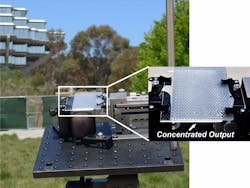PHOTOVOLTAICS: Waveguide creates planar micro-optic PV solar concentrator
Concentrating photovoltaic (CPV) systems use low-cost optics to focus sunlight onto smaller, high-efficiency semiconductor PV cells, compared to flat-plate silicon or thin-film PV designs. Typical concentrating designs include Fresnel lenses or focusing mirrors with custom coatings along with secondary optics to uniformly illuminate the PV cells. Creating an array of concentrator systems leads to hundreds of optical elements focusing light onto hundreds of individual cells, presenting large-scale alignment and manufacturing challenges. Connecting all these cells into a complete module raises both cost and complexity.
To mitigate these concerns, researchers at the University of California, San Diego (UCSD; La Jolla, CA) have developed an alternative CPV design that uses a planar waveguide to couple sunlight focused by a micro-optic lens array to a shared PV cell.
Spreading the risk
Micro-optic lenses focus sunlight onto small reflective facets fabricated on the backside of a slab waveguide to couple light into the waveguide by total internal reflection. Because the waveguide provides excellent beam homogenization, it acts as a secondary optical element and transports sunlight collected over the entire array to a single PV cell placed at the waveguide edge.
Alignment between the lenses and coupling regions becomes the main drawback to this geometry. For this reason, to create the concentrating optic, the research team turned to a self-aligned fabrication approach where the lens array is mounted to the waveguide (with a small gap for cladding) and used as a mask for developing photopolymer molded to the coupler profile. The remaining resist in noncritical locations is removed, leaving localized regions placed at each lens focus. The entire procedure can use roll-to-roll manufacturing processes, which could keep costs at a minimum.
Careful analysis of the coupling structure, lens parameters, and ray propagation through the waveguide determined the optimal geometry. A series of reflective 120°-apex symmetric prisms were well suited for waveguide coupling and compatible with self-alignment. Simulated results achieved 300× concentration with 82% optical efficiency.
The researchers fabricated and tested a proof-of-concept micro-optic concentrator using off-the-shelf components. The lens array created 120° prisms molded within 200 µm diameter spots. Experimental results showed only 32% of the light reached the waveguide edge with ±1° angular acceptance; however, a custom lens array should increase the optical efficiency by eliminating losses and aberrations associated with the stock part.
Graduate researcher Jason Karp from UCSD says, "We were looking for ways to build solar collectors based on the most inexpensive manufacturing platform available. Along the way, we realized how roll processing not only reduces cost but can address homogenization, alignment, and assembly concerns as well." The research was funded by the National Science Foundation SGER (ECCS-0844274) and the California Energy Commission EISG (55780A/08-04).
REFERENCE
- J.H. Karp et al., Optics Express 18, 2, 1122–1133 (Jan. 18, 2010).

Gail Overton | Senior Editor (2004-2020)
Gail has more than 30 years of engineering, marketing, product management, and editorial experience in the photonics and optical communications industry. Before joining the staff at Laser Focus World in 2004, she held many product management and product marketing roles in the fiber-optics industry, most notably at Hughes (El Segundo, CA), GTE Labs (Waltham, MA), Corning (Corning, NY), Photon Kinetics (Beaverton, OR), and Newport Corporation (Irvine, CA). During her marketing career, Gail published articles in WDM Solutions and Sensors magazine and traveled internationally to conduct product and sales training. Gail received her BS degree in physics, with an emphasis in optics, from San Diego State University in San Diego, CA in May 1986.
